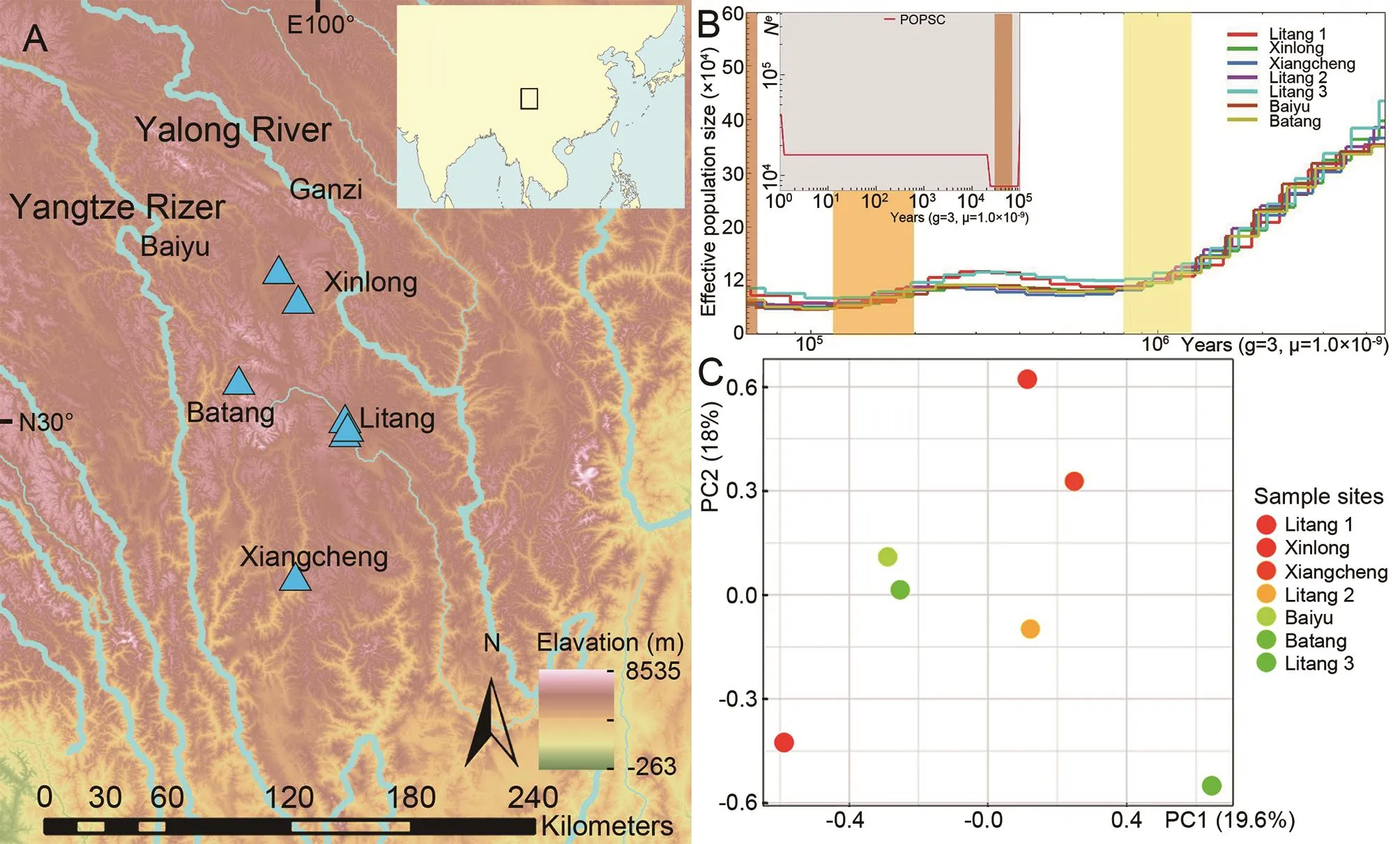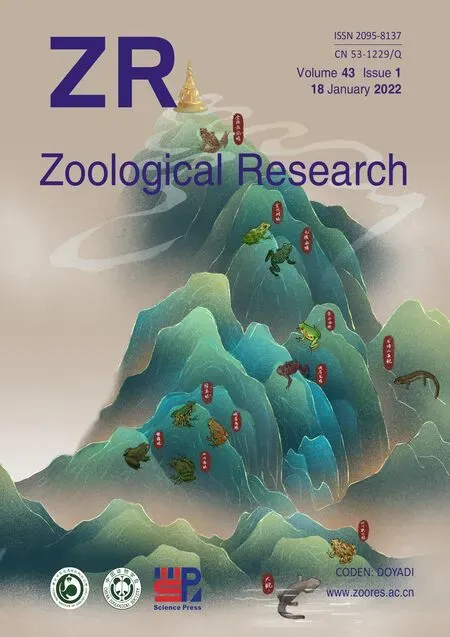Sichuan hot-spring snakes imperiled: reason, situation,and protection
The Sichuan hot-spring snake (Thermophis zhaoermii) is a rare and endemic species found at high elevations in the Hengduan Mountains of China.Recent species-specific investigations showed that the Sichuan hot-spring snake is still restricted to geothermal zones at elevations higher than 3 000 m a.s.l.The species also remains at risk of extinction, with the effective population size showing continual decline over the past one million years based on coalescent inference from genome-level single nucleotide polymorphism (SNP) data.We propose several approaches for protecting Sichuan hot-spring snake populations and their habitat.
Species-targeted investigations and analyses of genetic resources are fundamental for the conservation and management of biodiversity.Hot-spring snakes (genus Thermophis) are endemic to the Tibet-Himalaya-Hengduan region at elevations of 3 000 to 4 900 m a.s.l.Thermophis includes three endangered species: i.e., Tibetan hot-spring snake (T.baileyi), Sichuan hot-spring snake (T.zhaoermii),and Shangri-La hot-spring snake (T.shangrila)(Supplementary Figure S1).Congeners of the group are relict species that have survived long-term in the extreme environment and climate of the Tibet-Himalaya-Hengduan region due to their geothermal habitats and unique ecological adaptations (Hofmann et al., 2014).Although hot-spring snakes are considered threatened, no genetic data are currently available for living condition assessments, except for the Tibetan hot-spring snake (Hofmann et al., 2014).
In the current study, we evaluated the distribution area,genetic background, and status quo of the Sichuan hot-spring snake based on population genomics and observations obtained via species-targeted investigations.Furthermore,potential threats, current situation, and protection strategies of this species are discussed.
With a strong preference for thermal habitats, all hot-spring snakes show restricted and isolated distribution patterns.Tibetan hot-spring snakes are endemic to the Qinghai-Xizang(Tibet) Plateau (QTP), where they are recorded from ~20 thermal sites in the Yarlung Zangbo River valley (Hofmann et al., 2015), whereas others are found only in Hengduan Mountains.First discovered in western Sichuan, the Sichuan hot-spring snake was originally misidentified as the Tibetan hot-spring snake.This species is very rare and known only from its type locality and adjacent counties, with a handful of specimens (Hofmann et al., 2015).Despite comprehensive herpetofaunal surveys, T.zhaoermii is still restricted to a few scattered records in geothermal zones at elevations higher than 3 000 m a.s.l.along the central part of the Yalong River valley (Figure 1A).Based on new records, the distribution area of the Sichuan hot-spring snake was estimated to be 10 461 km2using a minimum convex polygon according to the International Union for Conservation of Nature (IUCN) Red List Categories and Criteria (v3.1).Although the area of occupancy seems large, it may contain many unoccupied habitats given the species geothermal dependency.Despite its wide range, Sichuan hot-spring snakes were only found in small and isolated subpopulations based on our surveys(Figure 1A), and thus are still considered to be highly restricted.
Small populations can be easily influenced by random genetic drift and fixation, which can be accelerated by inbreeding.To clarify the genetic background of Sichuan hotspring snakes, we conducted population genomic analysis using genome-wide single nucleotide polymorphism (SNP)data (see Supplementary Materials).The heterozygosity rateof theT.zhaoermiigenome was 1.75×10-3(Supplementary Table S1), higher than that estimated for the Chinese alligator(Alligator sinensis) (0.15×10-3) (Wan et al., 2013) andT.baileyi(0.30×10-3).The relatively high heterozygosity rate indicates thatT.zhaoermiimay still have higher genetic diversity, possibly due to a mixed genetic background, which may support successful survival despite the small and fragmented populations.However, the heterozygosity rate was lower than that of many other endangered animals, such as the Sumatran orangutan (Pongo abelii) (Prado-Martinez et al.,2013).Furthermore, high genetic diversity is not always correlated with current population size, with demographic history a potentially more important factor for estimating endangered status (Díez-del-Molino et al., 2018).
Population admixture analysis showed no significant genetic structuring among sampled localities, suggesting that allT.zhaoermiipopulations represent a single evolutionarily significant unit.In addition, the pairwise sequentially Markovian coalescent (PSMC) model was used to reconstruct demographic history with genomic re-sequencing data from seven individuals.Demographic history indicated thatT.zhaoermiihas experienced a prolonged population decline over the past one million years.All sequenced individuals showed a similar demographic history, whereas two Litang individuals showed a slight increase from ~600 000 to~300 000 years ago (Figure 1B).Estimations of effective population size (Ne) forT.zhaoermiiwere 10 000–20 000 at 10 000 years ago and 40 000 at ~4.5 million years ago.This prolonged decline in effective population size may demonstrate a range-wide decrease in snake densities, which could lead to extensive inbreeding and increased risk of extinction.

Figure 1 Distribution and population genomics of Sichuan hot-spring snake (Thermophis zhaoermii)
The survival of hot-spring snakes continues to be seriously threatened.Exploitation of geothermal resources and construction of hydropower stations are major threats to the survival ofThermophisspecies, especially Sichuan hot-spring snakes due to the distribution imbalance of geothermal resources (677 hot-springs in Xizang vs.339 in Sichuan)(Comprehensive Scientific Investigation Team of Qinghai-Xizang Plateau, Chinese Academy of Sciences, 1994; Tong et al., 2000).Notably, the development of hot-spring tourism in Sichuan may encroach onT.zhaoermiihabitat (Shao, 2012),leading to habitat degradation, water pollution, and limited access to food resources.
Although the genetic diversity ofT.zhaoermiiis relatively high, loss of genetic diversity remains a threat to the small and endangered populations.Populations that are threatened by human activities and show continuing declines can experience an increase in inbreeding.Consequently, loss of genetic diversity and small population size can still threaten long-term viability, and the small populations ofT.zhaoermiiaround thermal sites may be easily eradicated to “site extinction”.
Nevertheless,T.zhaoermiiwas only recently listed as a nationally protected species in China (National Forestry and Grassland Administration of China, 2021, http://www.forestry.gov.cn/main/586/20210208/095403793167571.html), and is in urgent need of relevant measures for protection.
To ensureT.zhaoermiiprotection, the following strategies should be considered.Nationally protected species are provided with legal justification for species protection.TheIUCN initially placed T.zhaoermii in the category of Endangered: B1ab(iii) (Guo & Jiang, 2014).However, the species was recently classified as Critically Endangered:A2acde+3cd+4cd in China‘s Biodiversity Red List (Wang et al., 2021), indicating that populations have continued to decline.Based on our newly obtained data, we also recommend T.zhaoermii be classified as Critically Endangered following the IUCN classification criteria.
Although known as a “hot-spring snake”, we found that T.zhaoermii only occurred in about one quarter of the investigated hot-springs, which may allow for both species conservation and economic development.Specifically, before the construction of hydropower stations and exploitation of geothermal resources, detailed population surveys should be conducted to guide policy decisions.For sites within the key distribution region, species-targeted nature reserves should be established to protect and restore Sichuan hot-spring snake populations.Long-term population monitoring should also be conducted to monitor the population dynamics of T.zhaoermii,especially in distribution sites with local construction projects.We emphasize the need to maintain conservation efforts,which have helped prevent the extinction of T.zhaoermii, and provide a genomic resource for future conservation and research.
DATA AVAILABILITY
The whole-genome sequencing data information of the hotspring snake specimen can be accessed through the NCBI BioProjectID PRJNA788580.The raw data used in this study was deposited in the Genome Sequence Archive(https://ngdc.cncb.ac.cn) in the China National GenBank Database (CNGBdb) under accession No, CRA005587.
SUPPLEMENTARY DATA
Supplementary data to this article can be found online.
COMPETING INTERESTS
The authors declare that they have no competing interests.
AUTHORS’ CONTRIBUTIONS
J.T.L.initiated and conceived the current work.J.L.R., C.C.Y.,and Z.L.P.prepared the manuscript with input from all authors.All authors read and approved the final version of the manuscript.
Jin-Long Ren1,2, Chaochao Yan1, Zhong-Liang Peng1,2,Jia-Tang Li1,2,3,*
1Chengdu Institute of Biology, Chinese Academy of Sciences,Chengdu, Sichuan 610040, China
2University of Chinese Academy of Sciences, Beijing 100049,China
3Mangkang Ecological Station, Xizang Ecological Safety Monitor Network, Changdu, Xizang 854500, China
*Corresponding author, E-mail: lijt@cib.ac.cn
- Zoological Research的其它文章
- Rapid genetic divergence and mitonuclear discordance in the Taliang knobby newt (Liangshantriton taliangensis, Salamandridae, Caudata) and their driving forces
- Lack of transcriptional coordination between mitochondrial and nuclear oxidative phosphorylation genes in the presence of two divergent mitochondrial genomes
- Capsid protein from red-spotted grouper nervous necrosis virus induces incomplete autophagy by inactivating the HSP90ab1-AKT-MTOR pathway
- A new species of the genus Kurixalus (Anura:Rhacophoridae) from Sichuan Province, southwestern China
- A new species of Occidozyga Kuhl and van Hasselt,1822 (Anura: Dicroglossidae) from Southern Guangxi, China
- Role of Cyp19a1 in the female pathway of a freshwater turtle species (Mauremys reevesii) with temperaturedependent sex determination

